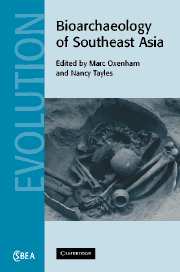Book contents
- Frontmatter
- Contents
- List of contributors
- Foreword: Emerging frontiers in the bioarchaeology of Southeast Asia
- Preface
- 1 Introduction: Southeast Asian bioarchaeology past and present
- Part I Morphological diversity, evolution and population relationships
- 2 The population history of Southeast Asia viewed from morphometric analyses of human skeletal and dental remains
- 3 A multivariate craniometric study of the prehistoric and modern inhabitants of Southeast Asia, East Asia and surrounding regions: a human kaleidoscope?
- 4 Interpretation of craniofacial variation and diversification of East and Southeast Asians
- 5 New perspectives on the peopling of Southeast and East Asia during the late upper Pleistocene
- 6 Human variation and evolution in Holocene Peninsular Malaysia
- 7 Dentition of the Batak people of Palawan Island, the Philippines: Southeast Asian Negrito origins
- Part II Health, disease and quality of life
- Part III Conclusions
- Index
- References
7 - Dentition of the Batak people of Palawan Island, the Philippines: Southeast Asian Negrito origins
Published online by Cambridge University Press: 18 November 2009
- Frontmatter
- Contents
- List of contributors
- Foreword: Emerging frontiers in the bioarchaeology of Southeast Asia
- Preface
- 1 Introduction: Southeast Asian bioarchaeology past and present
- Part I Morphological diversity, evolution and population relationships
- 2 The population history of Southeast Asia viewed from morphometric analyses of human skeletal and dental remains
- 3 A multivariate craniometric study of the prehistoric and modern inhabitants of Southeast Asia, East Asia and surrounding regions: a human kaleidoscope?
- 4 Interpretation of craniofacial variation and diversification of East and Southeast Asians
- 5 New perspectives on the peopling of Southeast and East Asia during the late upper Pleistocene
- 6 Human variation and evolution in Holocene Peninsular Malaysia
- 7 Dentition of the Batak people of Palawan Island, the Philippines: Southeast Asian Negrito origins
- Part II Health, disease and quality of life
- Part III Conclusions
- Index
- References
Summary
Introduction
The Batak are an indigenous people of Palawan Island, the Philippines (Krieger 1942, Eder 1987; see Fig. 1.2, p. 6), who speak an Austronesian language related to that of other peoples in the Palawan region and classified with the Visayan group of Philippine languages. The Batak closely resemble other so-called ‘Philippine Negritos’, both in their mobile hunting and gathering lifestyle and in their physical attributes (short stature, dark skin colour and curly hair), which earned these distinctive-looking people their name. Approximately two dozen ethnolinguistically distinct groups of such peoples are found in the Philippines, including the Mamanwa of Mindanao and a series of groups known variously as Agta, Ayta, Aeta, Ata or Ati, which are scattered widely in northern, eastern and west central Luzon, the Bikol Peninsula and the islands of Panay and Negros. The total number of these peoples is difficult to estimate with any accuracy but is probably in the order of 15 000–20 000 persons (Eder 1987).
Philippine Negritos, in turn, resemble other small, dark, hunting and gathering folk of Southeast Asia, in particular the Andaman Islanders and the Semang of the Malay Peninsula. Collectively, Southeast Asian Negritos have long been presumed to represent the surviving remnants of what was once a more widespread and more racially and culturally homogeneous population (e.g. Cooper 1940, Fox 1952). Such claims remain speculative.
- Type
- Chapter
- Information
- Bioarchaeology of Southeast Asia , pp. 172 - 188Publisher: Cambridge University PressPrint publication year: 2006
References
- 3
- Cited by



